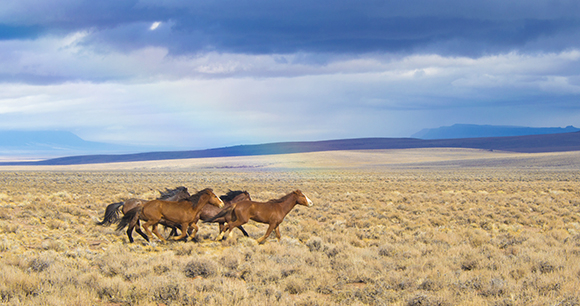
Management plan amendments would “zero out” Salt Wells Creek and Great Divide Basin Herd Management Areas in Wyoming Checkerboard, while slashing the size of protected habitat in Adobe Town
Rock Springs, WY—The Animal Welfare Institute (AWI) and American Wild Horse Campaign (AWHC), along with prominent wildlife photographers Kimerlee Curyl and Carol Walker, submitted a formal protest yesterday opposing proposed amendments to two Bureau of Land Management (BLM) Resource Management Plans (RMPs) that would result in the largest-ever removal of wild horses from the range and elimination of their designated habitat.
The protest is the culmination of a longstanding battle to defend the wild horses of the Wyoming Checkerboard against demands by the Rock Springs Grazing Association (RSGA)—whose own livestock roam freely in the area—to remove these federally protected animals from more than 2 million acres of land in the southwestern part of the state.
If the BLM proceeds with its plan after reviewing the protest, AWI and AWHC will consider all legal options, including litigation.
“The unprecedented and draconian wild horse reductions proposed by the BLM violate the Wild Free-Roaming Horses and Burros Act, the Administrative Procedure Act, and the National Environmental Policy Act,” said William S. Eubanks II of Eubanks & Associates, which filed the protest on behalf of the groups. “The plan sets a dangerous precedent for private landowners to dictate whether federally protected wild horses will be allowed to live in their designated habitats on public lands, and threatens to undermine federal protections for wild horses across the West.”
The RMP amendments, published last month in the Federal Register, would eliminate 2.1 million acres—43 percent of wild horse habitat—in Wyoming and slash by about one-third the allowed wild horse populations in the state by:
- Changing the status of the Salt Wells Creek and Great Divide Basin Herd Management Areas (HMA) to Herd Areas with a maximum population of zero wild horses across 1.9 million acres of land—i.e., “herd areas” with no horses. In places that are popular destinations for wild horse watchers and photographers, every single wild horse would be removed.
- Slashing the size of the Adobe Town HMA by approximately half and reducing the wild horse population to below the number that the BLM previously determined to be at a “thriving natural ecological balance” with other uses of the land.
The final amendments would preserve the White Mountain HMA as habitat for wild horses. The BLM dropped its plan to convert that population to a non-reproducing herd via surgical sterilization after local officials objected, citing negative impacts on this important ecotourism resource in the area.
“Despite public outcry, the BLM initiated the largest roundup of wild horses in US history last winter, permanently removing more than 3,500 mustangs from the Checkerboard region,” said Joanna Grossman, Ph.D., equine program manager and senior advisor at the Animal Welfare Institute. “That massive roundup coincided with the 50th anniversary of the landmark Wild Free-Roaming Horses and Burros Act and resulted in horrific injuries and fatalities to the horses involved. It also set the stage for the agency’s current strategy to eliminate millions of acres of designated habitat for wild horses. Should the BLM move forward, the repercussions will likely be felt across the West as the federal government could simply remove herds to placate private grazing interests.”
The RMP amendments are the result of a lawsuit filed more than a decade ago by the RSGA against the BLM demanding the removal of wild horses from all sections of the Wyoming Checkerboard, including those alternating public land parcels that are owned and managed in trust for the American public. RSGA members graze private livestock on the public lands within the Checkerboard and view wild horses as competition for cheap forage available through tax-subsidized grazing fees.
In 2013, the BLM settled the suit with a consent decree, which mandated only that the agency consider amending the governing RMPs to eliminate wild horse populations from all Checkerboard lands in the area.
- Marjorie Fishman, Animal Welfare Institute
[email protected], (202) 446-2128 -
Grace Kuhn, American Wild Horse Campaign
[email protected], (804) 218-4252
The Animal Welfare Institute is a nonprofit charitable organization founded in 1951 and dedicated to reducing animal suffering caused by people. AWI engages policymakers, scientists, industry, and the public to achieve better treatment of animals everywhere—in the laboratory, on the farm, in commerce, at home, and in the wild. Follow us on Facebook, Twitter, and Instagram for updates and other important animal protection news.
The American Wild Horse Campaign (AWHC) is the nation's leading wild horse protection organization, with more than 700,000 supporters and followers nationwide. AWHC is dedicated to preserving the American wild horse and burros in viable, free-roaming herds for generations to come, as part of our national heritage. In addition to advocating for the protection and preservation of America's wild herds, AWHC implements the largest wild horse fertility control program in the world through a partnership with the State of Nevada for wild horses that live in the Virginia Range near Reno.